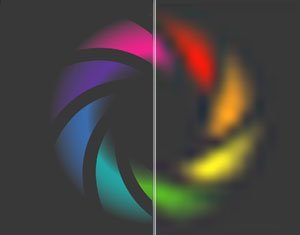Image Size & Resolution
Introduction
 Digital pictures have a size, measured in pixels, determined by the camera used. The resolution of an image, measured in dots-per-inch (DPI), is only relevant for printed images or in preparation for printing. For software which relies on DPI, the DPI can be set according to the desired print size. This does not affect in any way the image's pixels, it simply determines how many printer dots must be used to print each image pixel. If DPI is set too high, the printer capability may be exceeded and details will be lost, if DPI is set too low, the image will appear soft and blurry, therefore it is recommended to keep DPI between 72 and 300. For displayed images, DPI is determined by the size of a monitor's pixels and the magnification. A computer display usually has DPI between 72 and 128.
Digital pictures have a size, measured in pixels, determined by the camera used. The resolution of an image, measured in dots-per-inch (DPI), is only relevant for printed images or in preparation for printing. For software which relies on DPI, the DPI can be set according to the desired print size. This does not affect in any way the image's pixels, it simply determines how many printer dots must be used to print each image pixel. If DPI is set too high, the printer capability may be exceeded and details will be lost, if DPI is set too low, the image will appear soft and blurry, therefore it is recommended to keep DPI between 72 and 300. For displayed images, DPI is determined by the size of a monitor's pixels and the magnification. A computer display usually has DPI between 72 and 128.
Image Size & Resolution
Image size and resolution are each terms often used to describe different but related concepts. These concepts are important for those who wish to print their digital images. This feature attempts to explain the concepts clearly.
A digital image is composed of pixels. Each pixel represents one colored dot. Together, millions of pixels form an image. The term resolution is frequently used to describe the number of dots which form an image. For example, the resolution of a 3 megapixel image is often described as 2048 pixels wide by 1536 pixels high. Note that 2048 x 1536 is about 3 millions, thus the term megapixel. Photoshop, a popular image manipulation program by Adobe, calls this image size because it uses the term resolution to describe something different. With this definition, resolution does not describe the physical size of an image because the size of each pixel is not known, just how many there are.
The second meaning of the term resolution , the one used by Photoshop, relates pixels to physical size. With this meaning, resolution is measured in DPIdots-per-inch which is the number of dots which, when placed side to side against each other, would measure 1 inch. For example, a 100 DPI image has dots which measure 1/100 of an inch across. When the concepts of image size and resolution are combined (using Photoshop terminology), physical size can be deduced. For example, a 3000x2000 pixel image at 100 DPI has a physical size of 30" x 20".
Now, it is known that digital cameras produce images of a given number of pixels, but what is the resolution of a digital camera image? The real answer is that it depends on viewing or printing size. Therefore, a software cannot tell what the true DPI of an image is without additional input. This is when software like Photoshop can confuse people: it assumes a DPI until correctly set by a user. To do that, one has to access the resizing dialog, change the DPI with the resample option unselected. By unselecting the resample option, the software knows that it must not change the image's pixels in any way. Instead, it simply sets the DPI. Once the DPI of an image is correctly set, the software knows its intended physical size. Some image printing software figure out the right DPI by asking the user for a physical size. In such cases, a number of images sizes are offered and the software figures out what DPI is required. Remember that physical size, image size and image resolution are related, so if any two are known, the third one can be computed.
Printing
Once an image's DPI is set, it can be printed easily at a specific size. As noted above however, it is not required to set an image's DPI. In Photoshop, the DPI is used. That is really all that is needed to print an image yourself. Just as there are two ways to tell software how to print images, there are two ways to tell other people how to print images. Most photo labs ask for image size (such as 4x6, 5x7 or 8x10) and they figure out what DPI to use. Other places, won't ask for size but will require a specific DPI. For example, publication magazines often request 300 DPI images. Of course, simply setting the DPI to 300 will set the image size.
 |
|
| DPI correct | DPI too low |
It is possible to produce an image of a specific DPI and a particular physical size using something called resampling. This is what the resample option in Photoshop does. To use resampling properly, physical size and DPI must be both set properly in Photoshop and the resampling option must be enabled. When an image is resampled, its pixels are replaced by new ones to give the impression that the image is unchanged. Suppose a 300 DPI 8x10 image is required. Logically this implies 2400x3000 pixels (roughly a 7 megapixel image). If an 8 megapixel image is made into a 7 megapixel image, as required by the previous example, details from the 8 megapixel image must be left out, this is called filtering. If a 3 megapixel image is made into a 7 megapixel image, then new pixels must be invented, this is called interpolation. Interpolated images appear soft and blurry because they have more pixels but not more details. This is exactly why images cannot be printed at any size and why large print sizes require higher megapixel cameras.
Displaying
Computer displays and televisions have full-color pixels just like images. Each display pixel is just like a digital camera image pixel except that it has a fixed size. Thus, a display has a resolution in the Photoshop sense and a resolution in the image size sense. Note that displays can simulate different resolutions using something similar to interpolation.
When an image is viewed at 100% magnification, each image pixel appears in exactly one display pixel. In this case, the image's effective resolution , is the same as monitor's resolution and the selected image resolution is ignored. For example, a 22" monitorMonitor and TV sizes are measured diagonally which is 16" wide at 2048x1536 has a resolution of 128 DPI (2048/16 = 128). When an image is viewed at more than 100%, interpolation is used. Typical image viewing programs have a fit-to-fill mode which selects a magnification factor so that the image fits the entire window or screen. In fit-to-fill mode, an image which has less pixels than the window will be interpolated and an image which has more pixels will have pixels discarded. This explains why displaying images on a screen requires lower megapixels. Most common computer displays have less than 2 megapixels, so extra pixels of higher resolution images have to be discarded so that the entire image fits on the screen.
Printers
Printers too make images out of tiny dots. Most printers produce dots of a fixed size which is determined by the printer's resolution, also measured in DPI. Comparing image and printer resolutions can be confusing. At first glance, printers appear to have relatively very high resolutions (they are advertised as having up to 5600 DPI). The difference between an image's DPI and a printer's DPI is that each image dot can vary greatly in color and intensity, while a printer dot can be of exactly one color and intensity. For example, an image pixel must be reproduced using a number of printer dots. The combination of dots which tricks our eye into seeing a very specific color is called dithering.
Another fact complicates understanding a printer's resolution: the size of ink dropletsMeasured in picoliters. While a printer may advertise 5600 DPI which makes it seem like it can put 5600 dots side by side within one inch, droplets are typically not small enough for that. Thus, some printers may place a droplet at one of 5600 different positions within an inch, but cannot use consecutive positions. Therefore such a printer can not place 5600 dots within an inch. This is common among inkjet printers, where the paper type affects how much ink spreads and therefore the width of ink droplets on that paper type. Due to this fact, most printers can only print at their highest resolution on special paper that reduces the spreading of ink.
The relation between an image's resolution and a printer's resolution, determines how many printer dots can be used to simulate one image pixel.
 |
|
| Image pixels | Dithered pixels |
Please Support Neocamera
All information on Neocamera is provided free of charge yet running this website is a huge endeavor. Purchases made via affiliate links found throughout the site help keep it running and up-to-date. There is no additional cost to you, so please consider buying via these links to our affilates:
If you found any information on this site valuable and did not purchase via our affiliate links, please considering donating via PayPal:
Any amount will be greatly appreaciated. Thank you for your support!
Size/Resolution Calculator
Television
A television screen is made up of rectangular pixels. This means that the resolution (in the Photoshop sense) is different when measured horizontally than vertically. The consequence of this is that images displayed on a TV screen will appear deformed if they are not resampled. Because resampling produces different pixels than those in the original image, image quality is reduced. A standard TV has about 1/3 megapixel. The highest quality HDTV has roughly 2 megapixels.
Updates
2024.04.03

Fujifilm X-T5 Review
Newest Fujifilm flagship boasting a 40 MP APS-C sensor, 5-axis IBIS with 7-stop efficiency, 15 FPS continuous drive, 6.2K Video capture, dual control-dials and dual SDXC UHS-II slots in a sturdy weatherproof and freezeproof body.
2023.11.20

Best Digital Cameras of 2023
Find out which are the Best Digital Cameras of 2023. All the new Mirrorless Digital Cameras from entry-level to high-end professional.
2023.07.10

Fujifilm X-H2 Review
40 Megapixels APS-C Hybrid Mirrorless Digital Camera with 7-stop IBIS. Fastest shutter ever and 8K video capture. Large builtin EVF with 0.8X magnification and 5.8 MP, plus an Eye-Start Sensor. Packed with features and large number of controls in a weatherproof and freezeproof body.
2023.05.07

Sony FE 20-70mm F/4G Review
Review of the unique Sony FE 20-70mm F/4G lens. The optical zoom of this lens spans ultra-wide-angle and medium focal-length coverage, making it one of the most versatile Full-Frame lenses on the market.
2023.01.15

Huion Inspiroy Dial 2 Review
Review of the Huion Inspiroy Dial 2 tablet, a medium sized drawing surface with dual dials and customizable buttons. Connects via USB-C or Bluetooth 5.0 with Windows, Linux and Android support.
2022.12.08

How to Pack for a Photo Trip
Find out how to pack for a travel photography trip, carry your gear safely while meeting airline regulations.
2022.11.13

Best Digital Cameras of 2022
The best digital cameras of 2022. A short list of the most outstanding models in their respective categories. Choose one for yourself or as a gift.
2022.09.21

Pentax DA* 60-250mm F/4 SDM Review
Review of the Pentax DA* 60-250mm F/4 SDM, the constant-aperture telephoto zoom with the highest zoom-ratio on the market.
2022.09.20

Pentax DA* 50-135mm F/2.8 SDM Review
Review of the Pentax DA* 50-135mm F/2.8 SDM, the lightest professional telephoto zoom native to the K-mount.
2022.09.10

Pentax DA* 11-18mm F/2.8 DC AW Review
Review of the Pentax DA* 11-18mm F/2.8 DC AW, the widest professional ultra-wide zoom native to the K-mount.
2021.11.24

50 Gifts Under $50 For Photographers in 2021
50 Gifts photographers will love. All for under $50 USD. 2021 Edition.
2021.11.17

Best Digital Cameras for 2021
Neocamera shows which are the very best Digital Cameras for 2021 in every category: Mirrorless, DSLR, Premium Compact, Ultra-Zoom and Rugged.
2024.04.03
2023.11.20
2023.07.10
2023.05.07
2023.01.15
2022.12.08
2022.11.13
2022.09.21
2022.09.20
2022.09.10
2021.11.24
2021.11.17
NEWS
2024.04.16

Sony Launches Bright Ultra-Wide Compact Zoom
Lens
2024.03.27

Sigma Ultra-Bright Normal Mirrorless Lens
Lens
2024.03.27

Nikon Launches Full-Frame Super-Zoom Lens
Lens
2024.03.20

New Lens Statistical Comparisons
2024.03.14

Fujifilm Brings New Features to Instax Series
Instant Camera
2024.03.07

Leica Launches SL3 Full-Frame Mirrorless
Digital Camera
2024.02.22

Panasonic Unveils Full-Frame Travel-Zoom Lens
Lens
2024.02.21

Sigma Reveals 2 Extreme Full-Frame Lenses
Lens
2024.02.21

Sony Reveals Bright Compact Full-Frame Zoom
Lens
2024.02.20

Venus Launches First Autofocus Lens
Lens
2024.02.20

Fujifilm Launches X100VI
Digital Camera
2024.01.16

Think Tank Launches Backlight Sprint Backpacks
Bag







